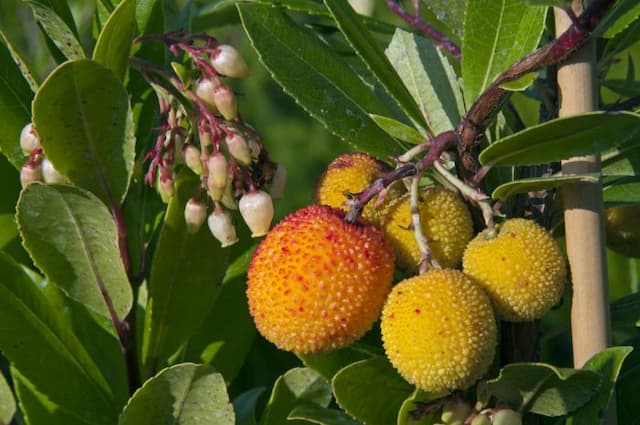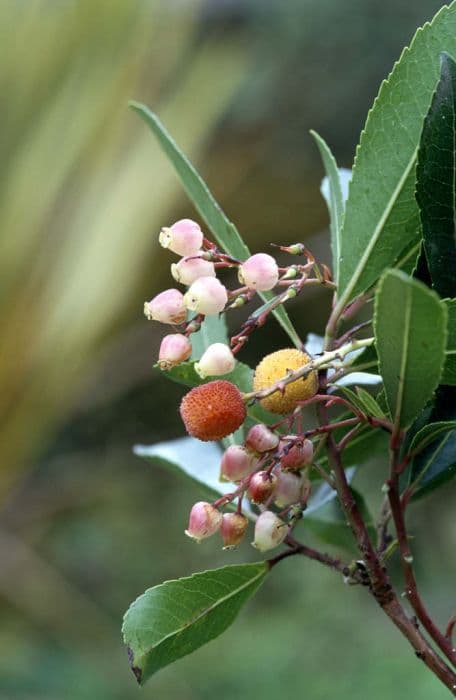Rhododendron Rhododendron (Argosy Group) 'Argosy'

ABOUT
The Rhododendron 'Argosy', belonging to the Argosy Group, is a striking plant known for its lush, evergreen foliage and magnificent blooms. Its leaves are dark green and leathery, forming a dense backdrop that accentuates the plant's vibrant flowers. These blooms are typically large and showy, clustering at the ends of the branches to create a dramatic floral display. The flowers come in a range of colors such as pinks, reds, purples, whites, and sometimes yellows, often with speckled or contrasting markings on the inner petals, which adds to their ornate appearance. During the blooming period, the Rhododendron 'Argosy' becomes a focal point in the garden, drawing attention with its bold colors and large, bell-shaped flowers. Each individual flower consists of a tubular base that flares open into five distinct lobes, often with wavy or ruffled edges that contribute to its overall aesthetic appeal. The blossoms are typically held in spherical clusters that can contain several individual flowers, creating a lush, rounded inflorescence that is visually striking against the glossy evergreen leaves. The structure of the Rhododendron 'Argosy' is typically robust, with branches that are strong enough to hold the weight of the large flowers and foliage. The overall form of the plant is well-rounded and symmetrical, making it an excellent addition as a specimen plant in garden designs. Whether in bloom or not, the Rhododendron 'Argosy' is a plant that exudes elegance and adds a sense of luxury to the landscape. With proper care and favorable conditions, it becomes a long-lived and cherished feature in gardens appreciative of its beauty.
About this plant
 Names
NamesSynonyms
Rhododendron, Azalea.
Common names
Rhododendron (Argosy Group) 'Argosy'.
 Toxicity
ToxicityTo humans
Rhododendron, including the 'Argosy' variety, is toxic to humans if any part of the plant is ingested. The plant contains grayanotoxins, which can affect the body's sodium channels and lead to poisoning. Symptoms of rhododendron poisoning may include nausea, vomiting, drooling, diarrhea, confusion, weakness, and decreased blood pressure. In severe cases, cardiac problems, coma, and even death can occur, although such extreme reactions are rare.
To pets
Rhododendron is also toxic to pets, such as dogs and cats, if ingested. Containing the same grayanotoxins as it does for humans, it can cause pets to exhibit symptoms like vomiting, diarrhea, drooling, weakness, and lack of coordination. In severe cases, it can lead to a drop in blood pressure, coma, and potentially death. Pet owners should prevent their animals from chewing on any part of this plant.
 Characteristics
CharacteristicsLife cycle
Perennials
Foliage type
Evergreen
Color of leaves
Green
Flower color
Varies
Height
5 feet (1.52 meters)
Spread
5 feet (1.52 meters)
Plant type
Shrub
Hardiness zones
5
Native area
Asia
Benefits
 General Benefits
General Benefits- Ornamental Value: Rhododendrons, including the 'Argosy' variety, are widely appreciated for their stunning flowers that can add vibrant colors and visual interest to any garden.
- Landscape Design Versatility: They can be used in various landscape designs, including woodland gardens, shade gardens, and as specimen plants.
- Erosion Control: Rhododendrons have a dense root system that can help stabilize soil on slopes, reducing the risk of erosion.
- Habitat Support: These plants provide shelter and nesting sites for birds, while the flowers can attract pollinators such as bees and butterflies.
- Seasonal Interest: They offer spring interest with their blossoms and can maintain visual appeal throughout the year with evergreen foliage in many varieties.
- Privacy Screening: Due to their size and density, rhododendrons can be planted to form a natural privacy screen or hedge.
- Low Maintenance: Once established, rhododendrons require minimal care, making them a convenient choice for gardeners of all skill levels.
- Adaptability: The Argosy Group rhododendrons are adapted to a range of temperate climates, making them a versatile choice for many gardeners.
 Medical Properties
Medical PropertiesThis plant is not used for medical purposes.
 Air-purifying Qualities
Air-purifying QualitiesThis plant is not specifically known for air purifying qualities.
 Other Uses
Other Uses- Rhododendrons can be used to create natural dyes for fabrics. The flowers especially can provide a range of colors from pinks to purples when used in traditional dyeing techniques.
- These plants can be used in bonsai culture, where they are carefully pruned and shaped over years to create miniature representations of natural trees.
- Rhododendrons are used as motifs in art and design, often appearing in paintings, textiles, and decorative elements due to their showy blossoms and attractive foliage.
- The wood of some Rhododendrons is used in small-scale woodworking projects. Although not common, it can be utilized for crafting decorative items such as picture frames or jewelry boxes.
- In some cultures, Rhododendron leaves are used to ferment and make a kind of beer or wine, although this is not widespread due to toxicity concerns in many species.
- These plants are used in landscaping to stabilize soil and prevent erosion on slopes due to their extensive root system.
- Rhododendron petals can be used as confetti for outdoor celebrations, decomposing naturally and providing a more environmentally friendly alternative to paper or plastic confetti.
- The plant can be cultivated as a part of a sensory garden. The variety of colors and the texture of the leaves can be stimulating and calming for individuals with sensory processing needs.
- They can serve as a natural insect repellent, as some species of Rhododendron have been known to emit a fragrance that deters certain insects and pests.
- Rhododendrons are often used in photography and film as a picturesque backdrop for portraits and scenic shots because of their lush and vibrant appearance.
Interesting Facts
 Feng Shui
Feng ShuiThe Rhododendron is not used in Feng Shui practice.
 Zodiac Sign Compitability
Zodiac Sign CompitabilityThe Rhododendron is not used in astrology practice.
 Plant Symbolism
Plant Symbolism- Beware: Rhododendrons can symbolize caution or danger due to the toxicity of their leaves and nectar, which can be harmful if ingested.
- Warning: Similarly, they can signify a warning to pay attention to upcoming obstacles or tread carefully in certain situations.
- Elegance and Wealth: Due to their lush, full blooms and often vibrant colors, rhododendrons are associated with elegance and wealth, reflecting their status as a desirable ornamental plant in gardens.
- Survival: Rhododendrons are hardy plants capable of surviving in challenging environments, and thus they symbolize one's ability to thrive despite difficulties.
- Beauty: With their attractive and impressive flowers, they represent natural beauty and often grace gardens with their presence.
 Water
WaterRhododendrons require consistent moisture to thrive, but must not be waterlogged. Water the 'Argosy' Rhododendron thoroughly once a week by slowly soaking the area around the roots. During hot or dry weather, increase watering to twice per week, ensuring at least one inch of water is supplied each time. Cut back in cooler or rainy periods to prevent root rot. Use about 1-2 gallons of water to ensure deep soil penetration, promoting a strong and healthy root system.
 Light
LightThe 'Argosy' Rhododendron prefers dappled sunlight or partial shade. It thrives when shielded from intense midday sun, which can scorch its leaves, so situate it in a location that receives morning light and afternoon shade. An ideal spot would be under the canopy of tall trees that provide filtered sunlight.
 Temperature
TemperatureRhododendrons like 'Argosy' enjoy moderate temperatures and can tolerate a range between 20 to 80 degrees Fahrenheit. However, they thrive best at a temperature range of 60 to 70 degrees Fahrenheit. Protect the plant from severe frost and ensure it's not exposed to temperatures below 20 degrees Fahrenheit for prolonged periods to prevent damage.
 Pruning
PruningPrune the 'Argosy' Rhododendron to maintain shape and encourage bushier growth. The best time to prune is shortly after the flowers have faded in the spring. Do not prune too late in the season as it can affect next year's blooms. Remove any dead or diseased branches, old flowers, and thin out dense areas to improve air circulation within the plant.
 Cleaning
CleaningAs needed
 Soil
SoilRhododendrons require acidic soil with a pH between 4.5 and 6.0. A mix of 50% peat moss and 50% pine bark provides good drainage and aeration, important for rhododendron's healthy root growth. It's essential to avoid alkaline soils and heavy clays for the best growth of your rhododendron.
 Repotting
RepottingRhododendrons, including 'Argosy', typically need repotting every 2 to 3 years when they become root-bound. Repot in spring or early fall, choosing a slightly larger pot with good drainage, using the acidic soil mix recommended.
 Humidity & Misting
Humidity & MistingRhododendrons like 'Argosy' enjoy high humidity levels of around 40-60%. To maintain optimal humidity, place them in a location shielded from wind, and consider a layer of mulch to help retain soil moisture.
 Suitable locations
Suitable locationsIndoor
Provide bright, indirect light and ensure good airflow for indoor rhododendrons.
Outdoor
Plant in partial shade, shelter from wind, and mulch well for outdoor rhododendrons.
Hardiness zone
5-8 USDA
 Life cycle
Life cycleThe life cycle of the Rhododendron 'Argosy' begins with seed germination, which requires a moist and well-drained environment to stimulate growth. After germination, the seedling develops into a young plant with characteristic large leaves and begins the vegetative growth phase, during which it establishes a strong root system and foliar development. As the plant matures, it enters the flowering stage, typically in spring, showcasing clusters of vibrant flowers that attract pollinators for sexual reproduction. After pollination and fertilization, the flowers develop into seed capsules, which eventually release seeds, completing the reproductive cycle. Throughout its life, the Rhododendron 'Argosy' experiences periods of active growth and dormancy, with the latter usually occurring during the colder months when the plant conserves energy. With proper care, including adequate watering, light, and nutrient provision, the Rhododendron 'Argosy' can live for many years, sometimes even decades, going through these life stages repeatedly.
 Propogation
PropogationPropogation time
Spring-Early Summer
The most popular method of propagating Rhododendron 'Argosy' is through semi-hardwood cuttings. This process is typically carried out in the late summer. Cuttings should be taken from the current year’s growth, with each cutting measuring approximately 4 to 6 inches (10 to 15 centimeters) long. The lower leaves are removed, and the cut end is dipped in rooting hormone to encourage root development. The prepared cuttings are then placed in a well-draining potting mix, ensuring high humidity and consistent moisture. A rooting medium of peat and perlite often works well. It can take several weeks to a few months for the cuttings to root sufficiently before they can be transplanted.









